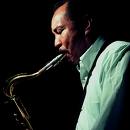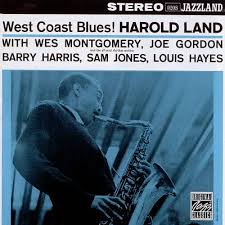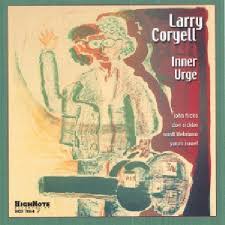Terrain – Harold Land
Harold Land's bop tunes are fascinating and challenging, especially in minor keys. This one is no exception, full of wide-interval peaks and valleys. Harold Land and Joe Gordon transcribed solos are available.
- Recording: Harold Land - West Coast Blues!
- Recorded on: May 17, 1960
- Label: Jazzland (JLP 20)
- Concert Key: B-flat minor
- Vocal Range: , to
- Style: Swing (medium up)
- Trumpet - Joe Gordon
- Tenor Sax - Harold Land
- Guitar - Wes Montgomery
- Piano - Barry Harris
- Bass - Sam Jones
- Drums - Louis Hayes
Video
- Description
- Historical Notes
- Solos
- Piano Corner
- Bass Corner
- Drum Corner
- Guitar Corner
- Inside & Beyond
- Minus You
Gordon's solo [link] is full of bebop-style lines that wind around chromatically in enclosures and passing tones. He breaks it up with some simpler, Miles Davis-esque phrases especially toward the beginning and end. His rhythms are almost as varied as Land's. Check out especially the third and fourth measures of A2 and C in the first chorus: almost the same notes but very different phrasing.
Both solo transcriptions have detailed articulations for a close look at these soloists' styles.
Pianist Michael Cochrane has provided one chorus of voicings using the solo chord progression (footballs). This set of voicings builds steadily over the course of the chorus. A1 is in a lower register, with voicings generally including the root and a half- or whole-step rub between the 3rd and 2nd, or 7th and 6th. A2's voicings are higher, not always with the root, with a combination of third- and fourth-based structures. The bridge has hits, which are given large voicings including the root. C starts even higher than A2 and descends. Also of note is the resolution between the second and third measures of A1 and A2: the third measures both have F on the top, but on A1 it is approached with G-flat and then A-flat on top while on A2 it is the reverse
These footballs show one way Michael hears the solo chord progression move from chord to chord. When studying them, your concentration can be focused solely on the chord progression and how chords move from one to another. Rhythmically, it's simple whole notes and half notes, or the basic harmonic rhythm of the chord progression of the solo section. The footballs are also annotated, showing the original chord symbol above the voicing, as well as any extensions below the voicing. The idea is that these voicings could be of varied uses to any level of pianist—a beginner pianist could play the music exactly as on the page and provide a supportive and harmonically hip sounding accompaniment to a soloist, while a more advanced pianist could use these same voicings with varied rhythms in the style of the recording. Ultimately, a pianist would be able to absorb how these voicings were derived from the chord symbols, and then be able to create their own.
Related Songs
Email Send Terrain to a friend
- Recording: Larry Coryell - Inner Urge
- Recorded on: February 23, 2000
- Label: HighNote (HCD 7064)
- Concert Key: B-flat minor
- Vocal Range: , to
- Style: Swing (medium)
- Trumpet - Don Sickler
- Guitar - Larry Coryell
- Piano - John Hicks
- Bass - Santi Debriano
- Drums - Yoron Israel
Purchase Terrain - Harold Land
Purchasing this song through our affiliate links with certain retailers provides jazzleadsheets.com with additional support to help keep us bringing you the best lead sheets available. Thank you!
Video
- Description
- Historical Notes
- Solos
- Piano Corner
- Bass Corner
- Drum Corner
- Guitar Corner
- Inside & Beyond
- Minus You
Note: the lead sheets available here are the same editions as shown under Harold's album.
Pianist Michael Cochrane has provided one chorus of voicings using the solo chord progression (footballs). This set of voicings builds steadily over the course of the chorus. A1 is in a lower register, with voicings generally including the root and a half- or whole-step rub between the 3rd and 2nd, or 7th and 6th. A2's voicings are higher, not always with the root, with a combination of third- and fourth-based structures. The bridge has hits, which are given large voicings including the root. C starts even higher than A2 and descends. Also of note is the resolution between the second and third measures of A1 and A2: the third measures both have F on the top, but on A1 it is approached with G-flat and then A-flat on top while on A2 it is the reverse
These footballs show one way Michael hears the solo chord progression move from chord to chord. When studying them, your concentration can be focused solely on the chord progression and how chords move from one to another. Rhythmically, it's simple whole notes and half notes, or the basic harmonic rhythm of the chord progression of the solo section. The footballs are also annotated, showing the original chord symbol above the voicing, as well as any extensions below the voicing. The idea is that these voicings could be of varied uses to any level of pianist—a beginner pianist could play the music exactly as on the page and provide a supportive and harmonically hip sounding accompaniment to a soloist, while a more advanced pianist could use these same voicings with varied rhythms in the style of the recording. Ultimately, a pianist would be able to absorb how these voicings were derived from the chord symbols, and then be able to create their own.
Larry's only other request was that my arrangement for him would end on a tonic B♭m chord. I can also hear it ending on a dominant chord, as Harold did in his arrangement, so I've left the Concert Condensed Score ending on Harold's F7(♯9)chord, with Harold's melody ending intact. I've indicated the optional vamp ending that you'll hear we used for Larry's recorded arrangement, along with a footnote that leads you here where you will see how I adjusted the melody to end in B♭m.
Here are the last two beats of measure seven of letter C going into the B♭m chord ending that occurs on the third time through the vamp ending on Larry's recording: [music example]
Related Songs
Email Send Terrain to a friend

Harold Land
February 18, 1928 – July 27, 2001
Many people only know of Harold Land as the great tenor saxophone soloist who made the classic quintet recordings with the Clifford Brown - Max Roach Quintet: Joy Spring, Daahoud, The Blues Walk and other classics—many of which are available from jazzleadsheets.com. Harold is far more than just a great tenor saxophonist sideman. Read more...


